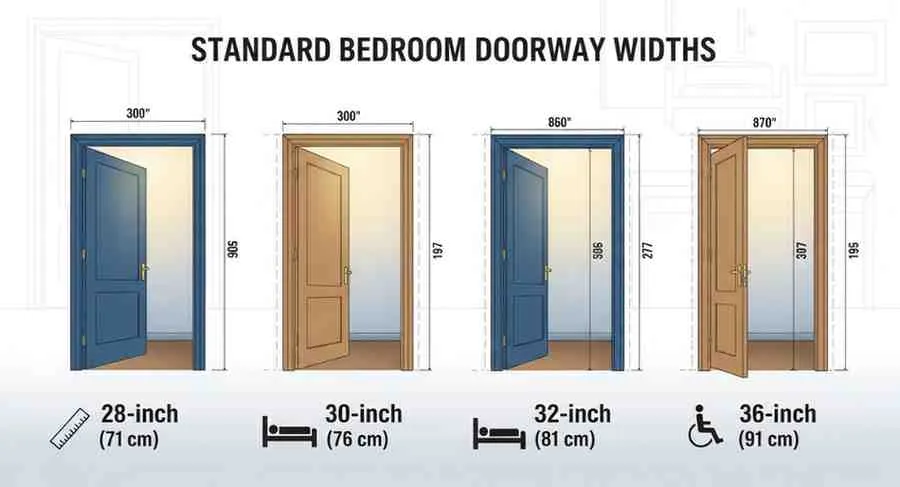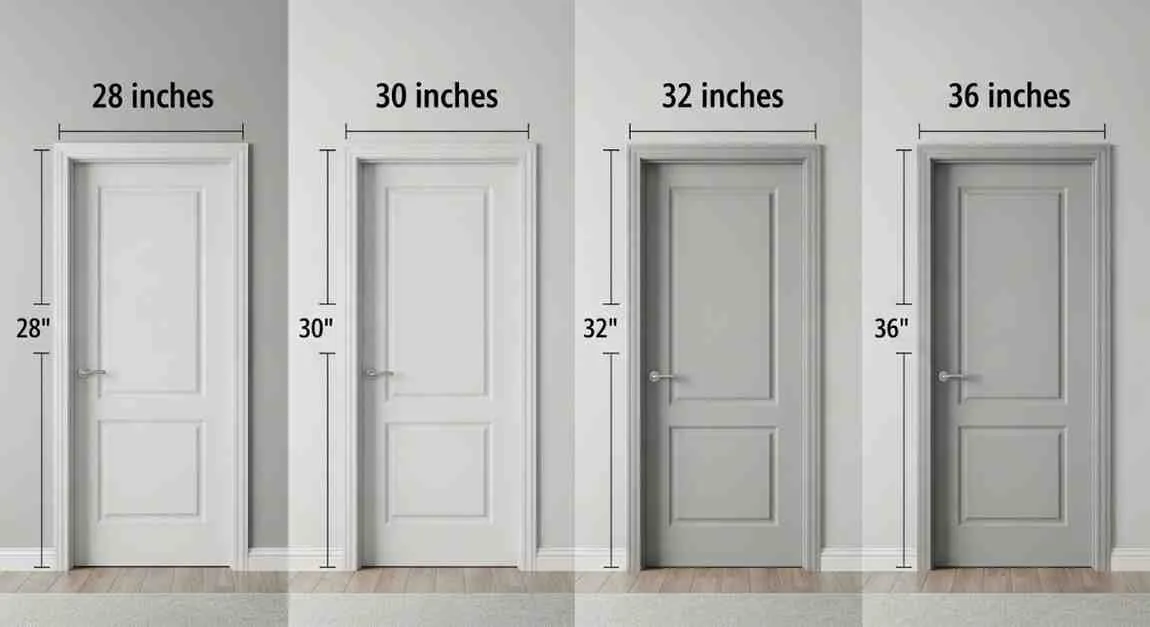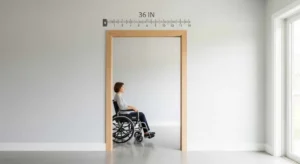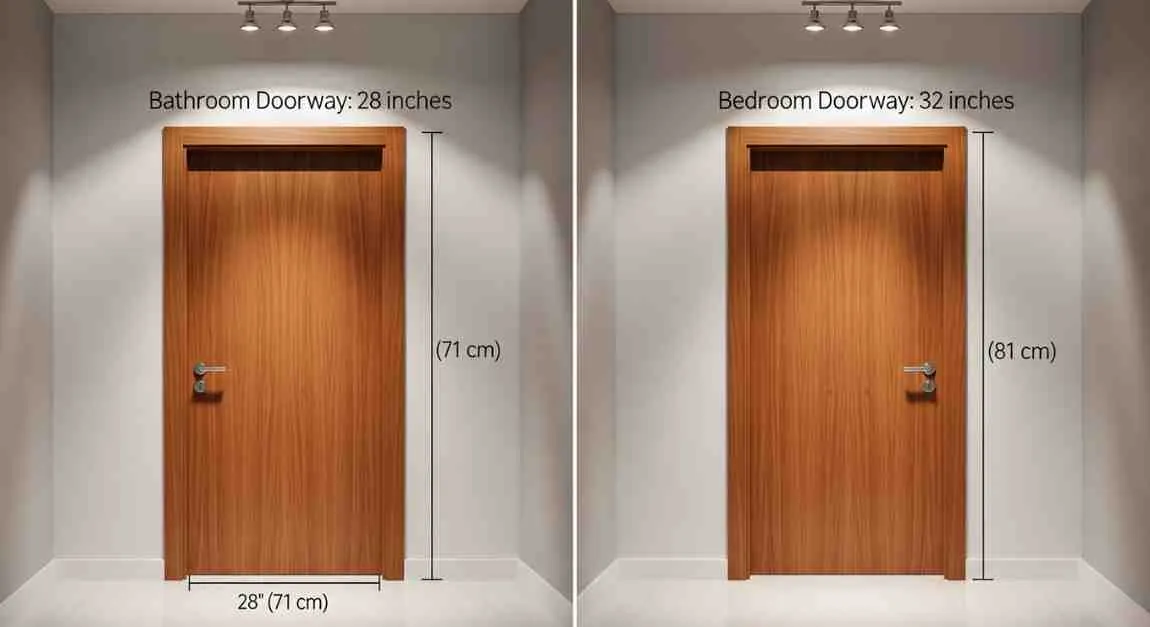Introduction
The doorway you walk through dozens of times each day rarely gets a second thought—until you’re trying to maneuver a king-sized mattress through a too-narrow opening, or a wheelchair user discovers your “standard” doorway doesn’t meet their accessibility needs. Bedroom doorway width is one of those seemingly minor construction details that has profound impacts on comfort, functionality, building code compliance, and home resale value.
Whether you’re building a new home, renovating an older property, or simply replacing interior doors, understanding interior door width standards is essential. Choose too narrow, and you’ll struggle with furniture delivery, limit accessibility, and potentially violate local building codes. Choose unnecessarily wide, and you’ll waste valuable wall space that could accommodate furniture, storage, or electrical fixtures.
The reality is that door width standards have evolved significantly over the past several decades. Homes built before 1990 often feature narrower doorways that don’t meet today’s accessibility guidelines. Modern construction emphasizes wider openings that accommodate diverse mobility needs and contemporary furniture sizes. Building codes now specify minimum dimensions, while accessibility requirements push those minimums even higher.
In this comprehensive guide, you’ll learn everything about bedroom door width, bathroom door width, and interior door size standards. We’ll cover common dimensions from 28 inches to 36 inches, explain the critical difference between rough openings and finished door widths, decode building code requirements, and help you choose the optimal doorway width for your specific situation. Whether you’re a homeowner planning a renovation, a builder ensuring code compliance, or a DIY enthusiast tackling interior carpentry, you’ll find the practical, fact-based information you need to make informed decisions about interior doorway dimensions.
Standard Bedroom Doorway Widths: Understanding Common Sizes
Interior door widths follow established standards, though these have evolved over time and vary based on when a home was built and its intended accessibility features.

The Most Common Bedroom Door Width Options
28-Inch Doors (2’4″ or 28″ × 80″)
Once extremely common, especially in bathrooms and smaller bedrooms:
- Historical use: Standard in homes built from 1950s through early 1990s
- Current status: Still code-compliant in many jurisdictions but increasingly rare
- Actual clear opening: Approximately 25.5-26 inches (accounting for door thickness and stop)
- Best suited for: Small bathrooms, closets, utility spaces in older homes
30-Inch Doors (2’6″ or 30″ × 80″)
The most common bedroom doorway width in modern residential construction:
- Market dominance: Used in approximately 60-70% of contemporary bedrooms
- Actual clear opening: Approximately 27.5-28 inches
- Building code status: Meets minimum requirements in most U.S. jurisdictions
- Practical use: Standard for bedrooms, home offices, dens, and larger bathrooms
- Balance point: Offers reasonable accessibility without sacrificing wall space
32-Inch Doors (2’8″ or 32″ × 80″)
Increasingly popular for accessibility and convenience:
- Growing adoption: Standard in new construction focusing on universal design
- Actual clear opening: Approximately 29.5-30 inches
- Accessibility: Meets ADA clear width requirements when fully open
- Advantages: Easier furniture movement, better wheelchair access, more light flow
- Cost: Typically $20-50 more than 30-inch doors
36-Inch Doors (3’0″ or 36″ × 80″)
Wider openings for specific purposes:
- Primary use: Master bedrooms, main entries to bedroom suites, accessible homes
- Actual clear opening: Approximately 33.5-34 inches
- Furniture advantage: Significantly easier for large furniture like armoires
- Accessibility: Exceeds all standard accessibility requirements
- Consideration: Requires more wall space, impacts furniture placement
How Door Widths Are Measured and Specified
Understanding carpentry door sizing terminology prevents costly ordering mistakes.
Nominal Size vs. Actual Size:
When you order a “30-inch door,” that’s the nominal size—the width of the door slab itself. However, several factors affect the actual opening:
Component breakdown:
- Door slab nominal width: 30 inches
- Door thickness: 1.375 inches (standard interior door)
- Door stop/jamb intrusion: 0.5-0.75 inches per side
- Resulting clear opening: Approximately 27.5-28 inches
This means a 30-inch bedroom door provides about 28 inches of actual passage width when open—a critical distinction for accessibility calculations.
Standard Door Notation:
Doors are typically specified as:
- 2’6″ × 6’8″ (30 inches wide × 80 inches tall)
- 2’8″ door width (32 inches)
- 30 inch bedroom door (nominal measurement)
All interior doors follow width × height format, with 80 inches (6’8″) being standard height unless otherwise specified.
New Construction vs. Older Homes: Width Standards Over Time
Pre-1950s Homes:
- Highly variable door widths, often 24-28 inches
- Hand-built openings without standardization
- Narrow passages reflecting smaller furniture and different accessibility expectations
1950s-1980s Construction:
- 28-inch bathroom door became standard
- 30-inch doors common for bedrooms
- Focus on cost efficiency and space maximization
- Limited accessibility considerations
1990-2010 Era:
- 30-inch became the default bedroom standard
- 32-inch doors appeared in higher-end homes
- Growing awareness of accessibility needs
- Building codes began specifying minimums
2010-Present:
- 32-inch interior doors increasingly standard
- Universal design principles influencing construction
- Baby boomer aging driving accessibility features
- Building codes requiring wider openings in specific applications
Regional Variations:
Some variation exists across regions:
- Western U.S.: Tends toward 32-inch standards in new construction
- Older Eastern cities: More 28-30 inch doors in historic properties
- Sunbelt states: New construction often features 32-36 inch accessibility-focused designs
- Rural areas: Greater variation based on local building traditions
Bathroom Door Widths Compared to Bedroom Doors

While bedrooms and bathrooms are both private spaces, their doorway width requirements differ based on function, space constraints, and building codes.
Why Bathrooms Traditionally Use Narrower Doors
Historical Reasons:
Bathrooms have conventionally featured the narrowest doors in a home:
- Space efficiency: Bathrooms are typically smaller rooms
- Privacy walls: Need solid wall space for fixtures like toilets
- Plumbing constraints: Walls contain water supply and drain lines
- Cost savings: Smaller doors reduce material costs in multiple-bathroom homes
The 28-Inch Bathroom Standard:
For decades, a 28 inch bathroom door was ubiquitous:
- Minimized the door’s swing arc in tight spaces
- Provided adequate privacy enclosure
- Met building codes in effect at the time
- Became an industry standard through repetition
Modern Shift Toward Wider Bathroom Doors:
Contemporary construction increasingly uses 30-32 inch bathroom doors:
- Accessibility requirements: Building codes now mandate wider access
- Aging in place: Homeowners planning for future mobility needs
- Furniture movement: Need to fit bathroom vanities, storage cabinets
- Resale value: Wider doors appeal to broader buyer pool
When Wider Bathroom Doors Are Required
Building Code Triggers:
Most jurisdictions require wider bathroom doors in specific situations:
Accessible/ADA-Compliant Bathrooms:
- Minimum 32-inch door (providing approximately 30 inches clear width)
- Required for at least one bathroom in new multifamily construction
- Mandated in commercial buildings
- Increasingly expected in residential construction
Master Bathroom Standards:
- Typically 30-32 inches minimum
- Many builders use 32-36 inches as standard in master suites
- Reflects the room’s larger size and importance
Powder Rooms/Half Baths:
- May still use 28-inch doors in space-constrained situations
- 30 inches becoming more common even in small bathrooms
- Consider frequency of use and guest access
Bathroom Size Influence:
Door width often correlates with bathroom square footage:
- Small (35-40 sq ft): 28-30 inch door
- Medium (40-75 sq ft): 30-32 inch door
- Large (75-120 sq ft): 32-36 inch door
- Master suite (120+ sq ft): 32-36 inch door (sometimes double doors)
Practical Considerations: Bedroom vs. Bathroom Door Width
Should They Match?
Design philosophy varies:
Matching approach:
- Creates visual consistency throughout home
- Simplifies ordering and maintains spare parts
- Common in spec homes and production building
Differentiated approach:
- Bedrooms at 30-32 inches
- Bathrooms at 28-30 inches (where space-constrained)
- Master suite at 32-36 inches
- Allows optimization for each space’s unique needs
Recommendation: Prioritize function over uniformity. If your bathroom layout allows, matching or exceeding bedroom door width improves accessibility and future-proofs your home.
Building Codes and Accessibility Requirements for Interior Doorways
Understanding door width building code requirements ensures legal compliance and creates homes that serve diverse needs.
International Residential Code (IRC) Standards
The International Residential Code, adopted by most U.S. jurisdictions with local modifications, establishes minimum interior doorway standards.
IRC Minimum Interior Door Widths:
For bedrooms (habitable rooms):
- No universal minimum specified in base IRC
- Local amendments often require 30 inches minimum
- Some jurisdictions still permit 28 inches in existing homes
For bathrooms:
- No specific minimum in standard IRC
- Accessibility requirements override when applicable
- Practical minimum: 24 inches (extremely rare in modern construction)
Important caveat: While the IRC doesn’t mandate specific bedroom doorway width minimums for single-family homes, it does require that spaces be “accessible” for their intended function. Most building officials interpret this as 30 inches minimum.
Local Code Variations:
Always verify with your local building department:
- Municipal codes may exceed IRC minimums
- State amendments add requirements
- Historic districts may have special provisions
- Condo/HOA regulations might specify standards
ADA Door Width Requirements and Their Impact
The Americans with Disabilities Act (ADA) establishes accessibility standards that influence residential design even when not legally mandated.
ADA Clear Width Requirements:
For doorways to be considered accessible:
- Minimum clear opening: 32 inches (measured from door face to opposite stop when door is open 90 degrees)
- This typically requires a 36-inch nominal door or a 34-inch door with specific hardware
- For practical residential purposes, 32-inch doors provide approximately 29.5-30 inches of clear width, meeting functional accessibility needs
Where ADA Standards Apply Legally:
Required:
- Multifamily buildings with 4+ units (Fair Housing Act)
- Commercial spaces
- Government buildings
- Public accommodations
Not legally required but influential:
- Single-family homes (though increasingly adopted voluntarily)
- Home renovations (unless receiving federal funding)
- Private residences
Why Homeowners Should Care About ADA Standards:
Even when not required:
- Future-proofing: Accommodates aging homeowners
- Resale value: Broader market appeal
- Guest accommodation: Welcomes visitors with mobility needs
- Furniture movement: Wider doors ease logistics
- Universal design: Creates homes that work for everyone
Rough Opening vs. Finished Interior Doorway Size
Understanding the relationship between framing and finished dimensions is essential for proper installation.
Rough Opening Dimensions:
The interior doorway rough opening is the framed opening before jamb installation:
Standard formula: Rough Opening Width = Door Width + 2 inches
Examples:
- 30-inch door requires 32-inch rough opening
- 32-inch door requires 34-inch rough opening
- 36-inch door requires 38-inch rough opening
Why the extra space?
- Door jamb thickness: 0.75 inches per side
- Shimming space: 0.25-0.5 inches per side for leveling and alignment
- Typical breakdown: 1 inch per side total
Height considerations:
- Standard 80-inch door requires 82.5-inch rough opening
- Allows for jamb, shimming, and clearance
Finished Opening vs. Clear Opening:
- Finished opening: Jamb to jamb measurement (approximately door width + 1-1.5 inches)
- Clear opening: Actual passable space with door open (approximately door width – 2-2.5 inches)
This distinction matters for accessibility calculations and furniture movement planning.
Fire Code and Egress Considerations
While most interior doors don’t serve as egress (emergency exit) routes, some bedrooms have specific requirements.
Bedroom Egress Windows (Not Doors):
Building codes require bedrooms to have emergency escape routes:
- Typically satisfied by windows, not doors
- Interior bedroom doors rarely subject to egress door requirements
- Exception: Bedrooms accessible only through other bedrooms may need specific door standards
Fire-Rated Door Requirements:
Certain locations require fire-rated interior doors:
- Doors leading to attached garages: typically 20-minute fire rating
- Between living space and garage: often mandated
- Generally doesn’t affect bedroom door width specifications
Key Point: For standard bedroom and bathroom doors, fire codes rarely dictate width. Focus on building codes and accessibility standards instead.
Choosing the Right Door Width for Your Home

Selecting optimal interior door dimensions balances accessibility, functionality, space efficiency, and budget considerations.
For Accessibility: Meeting Universal Design Principles
Wheelchair Accessibility Standards:
Manual wheelchairs typically measure:
- Standard width: 24-27 inches
- Clearance needed: Minimum 30 inches for straight passage
- Comfortable clearance: 32+ inches for easy navigation
- Turning space: 60-inch diameter circle required in rooms
Door Width Recommendations:
Minimum for basic wheelchair access:
- 32-inch door (provides approximately 30 inches clear opening)
- Allows straight-through passage
- May be tight for some power wheelchairs or scooters
Optimal for comfortable wheelchair access:
- 36-inch door (provides approximately 34 inches clear opening)
- Accommodates all standard mobility devices
- Provides maneuvering room
- Future-proofs for potential mobility aid changes
Walker and Cane Access:
Less restrictive than wheelchairs but still benefits from wider doors:
- 30-inch door typically sufficient
- 32-inch provides easier passage with assistive devices
- Wider doors reduce risk of scraping knuckles or catching devices
Aging-in-Place Planning:
If you’re building or renovating with long-term residence in mind:
- Use 32-inch doors as minimum throughout main living areas
- Install 36-inch doors in master bedroom and bathroom
- Consider 36-inch entry to bedroom suite
- Plan for future grab bar installation in bathrooms (requires door clearance)
For Tight Spaces: Maximizing Room Functionality
When Narrower Doors Make Sense:
Despite the trend toward wider openings, smaller doors remain appropriate in specific situations:
Space-Constrained Bathrooms:
- When wall space is needed for toilet, sink, shower placement
- In powder rooms where maximum accessibility isn’t priority
- Older home renovations where structural changes are impractical
Closet Doors:
- Standard closets may use 24-30 inch doors
- Smaller openings preserve interior storage configuration
- Bifold or sliding doors alternative for very tight spaces
Small Bedroom Access:
- In tiny bedrooms (8×10 feet or smaller)
- When maximizing usable wall space for furniture is critical
- Guest rooms with minimal accessibility requirements
Door Swing Clearance Issues:
Narrow doors require less swing clearance:
- 30-inch door: 30-inch arc
- 36-inch door: 36-inch arc
- In tight hallways or rooms, this difference impacts functionality
Space-Saving Door Alternatives:
When standard swing doors prove problematic:
- Pocket doors: Slide into wall cavity, zero swing space
- Barn doors: Slide along wall surface, require wall space but no swing area
- Bifold doors: Reduce swing arc by 50%
- French doors: Two narrower panels may work where one wide door doesn’t
For Moving Furniture: Practical Width Considerations
One of the most overlooked aspects of door width selection: will your furniture fit?
Common Furniture Dimensions:
Understanding typical furniture sizes helps predict door width needs:
Bedroom furniture:
- Twin mattress: 38 × 75 inches (fits through 30-inch door at angle)
- Full mattress: 54 × 75 inches (challenging through 30-inch door)
- Queen mattress: 60 × 80 inches (requires 32+ inch door)
- King mattress: 76 × 80 inches (requires 32+ inch door, difficult even then)
- Dressers: 30-60 inches wide (narrow on-edge through 30-inch door)
- Armoires: 36-48 inches wide (require 32+ inch door)
Bathroom fixtures:
- Vanity cabinets: 24-60 inches wide (wider vanities need 32+ inch doors)
- Freestanding tubs: 60+ inches (may require 36-inch door or removal of door casing)
- Large shower enclosures: Pre-assembled units may dictate door width
The Diagonal Advantage:
Furniture fits through doors at an angle, not flat:
- A 30-inch door opening can accommodate items up to approximately 42-45 inches wide (when tilted diagonally)
- A 32-inch door expands this to 48-52 inches
- A 36-inch door handles items up to 54-60 inches
Professional Tip: Measure your largest existing furniture before finalizing door widths. If you plan to purchase large pieces like king beds or wide dressers, accommodate accordingly.
Renovation and Remodeling Considerations:
In existing homes:
- Can you remove door trim/casing temporarily for large item passage?
- Is removing and reinstalling doors practical for furniture delivery?
- Are windows large enough to pass furniture if doors won’t work?
- Should you widen doorways during renovation to prevent future issues?
Future-Proofing Your Home: Long-Term Planning
Resale Value Implications:
Door width affects home marketability:
28-inch doors:
- May signal “dated” construction to buyers
- Limits potential buyer pool (those with mobility needs)
- Could become point of negotiation or inspection issue
30-inch doors:
- Meets most buyers’ expectations
- Considered standard in current market
- Acceptable but not exceptional
32-inch doors:
- Increasingly expected in modern construction
- Appeals to accessibility-conscious buyers
- May become the expected standard within 5-10 years
36-inch doors (where appropriate):
- Signals quality construction and thoughtful design
- Particularly valued in master suites
- Can be a selling point for luxury or accessible homes
The “Invisible Upgrade” Phenomenon:
Wider doors are one of those improvements buyers may not consciously notice but subconsciously appreciate. They make homes feel more spacious, accessible, and modern without drawing attention to themselves.
Cost-Benefit Analysis:
Upfront cost difference:
- 28-inch to 30-inch door: Approximately $10-30 more
- 30-inch to 32-inch door: Approximately $20-50 more
- 32-inch to 36-inch door: Approximately $40-80 more
Long-term value:
- Improved accessibility: Priceless if needed
- Easier furniture logistics: Saves moving costs and frustration
- Broader resale appeal: Potentially thousands in home value
- Future renovation avoidance: Widening doorways later costs $500-1500+ per opening
Recommendation: When building new or doing major renovations, defaulting to 32-inch interior doors for bedrooms and main bathrooms is a modest upfront investment with substantial long-term benefits.
Standard Door Height: The Vertical Dimension

While width varies significantly, door height follows more consistent standards—though options exist for specific design needs.
The 80-Inch Standard Interior Door Height
6’8″ (80 inches) is the universal standard for residential interior doors in the United States.
Why 80 inches became standard:
- Accommodates 99%+ of population comfortably
- Provides adequate clearance (78-inch person + 2 inches)
- Efficient use of standard lumber lengths
- Cost-effective manufacturing and inventory
- Historical precedent dating back over a century
Actual clearance: When installed, 80-inch doors provide:
- Approximately 78.5-79 inches of clear passage height
- Accounts for door bottom clearance (typically 0.5-1 inch for carpet or flooring)
- Sufficient for even tall individuals
Taller Door Options: When and Why
84-Inch Doors (7’0″):
Four inches taller than standard, these doors serve specific purposes:
Common applications:
- Homes with 9-foot ceilings (maintains proportions)
- Modern/contemporary designs emphasizing vertical lines
- Master bedroom suites for luxurious feel
- Connecting to rooms with higher ceilings
Considerations:
- Cost premium: 20-40% more than 80-inch doors
- Requires custom jambs and framing
- Must ensure consistent heights (mixing 80″ and 84″ looks awkward)
- May not match existing doors in renovations
96-Inch Doors (8’0″):
Even taller openings for dramatic effect:
Typical uses:
- Homes with 10-foot+ ceilings
- Architectural statement pieces
- Luxury construction
- Oversized rooms requiring proportional doorways
Important notes:
- Significantly more expensive (50-100% premium)
- Custom framing required
- Structural header considerations for wider spans
- Generally limited to main living areas, not standard bedrooms
The Relationship Between Door Width and Height
Proportional Considerations:
Width and height should maintain pleasing proportions:
Standard 80-inch height:
- 30-inch width: 2.67:1 ratio (height:width)
- 32-inch width: 2.5:1 ratio
- 36-inch width: 2.22:1 ratio
These ratios feel balanced and familiar to the eye.
For taller doors:
- May warrant slightly wider openings to maintain proportions
- 84-inch doors often paired with 32-36 inch widths
- 96-inch doors typically 36 inches or wider
Ceiling Height Influence:
Room ceiling height should inform door height choices:
- 8-foot ceilings: 80-inch doors standard and appropriate
- 9-foot ceilings: 80-inch acceptable, 84-inch provides better proportion
- 10-foot ceilings: 84-96 inch doors recommended for visual balance
Practical Impact on Bedroom Doorway Width:
While height is relatively fixed at 80 inches, this standardization actually makes width decisions more critical:
- Height accommodates virtually everyone’s physical needs
- Width becomes the primary accessibility variable
- Focus your selection energy on width, not height
- Exception: Custom luxury construction where design drives both dimensions
Carpentry and Installation Considerations
Proper installation transforms door specifications into functional, well-operating doorways. Understanding interior framing for doors ensures successful results.
Framing an Interior Doorway: Rough Opening Basics
Structural Components:
An interior doorway consists of several key framing elements:
King Studs:
- Full-height studs on either side of the opening
- Carry load from above to floor
- Typically 2×4 or 2×6 lumber
Jack Studs (Trimmer Studs):
- Shorter studs inside king studs
- Support the header directly
- Typically 2×4 lumber
Header:
- Horizontal beam spanning the opening
- Carries load from above around the doorway
- Size depends on opening width and load
Sill Plate:
- Bottom horizontal member (if needed)
- Not present in standard interior doorways (floor is continuous)
- Used in exterior doors only
Calculating Rough Opening Dimensions:
Width calculation:
- Door slab width + 2 inches
- Example: 32-inch door = 34-inch rough opening
- Accounts for jamb (1.5 inches total) and shimming space (0.5 inches total)
Height calculation:
- Door slab height + 2.5 inches
- Example: 80-inch door = 82.5-inch rough opening
- Accounts for head jamb, shimming, and floor clearance
Header Sizing:
For interior non-load-bearing walls:
- Opening up to 32 inches: Double 2×4 header acceptable
- Opening 32-48 inches: Double 2×6 header recommended
- Opening 48-60 inches: Double 2×8 header typical
For load-bearing walls, consult structural requirements (often requires engineered headers).
Door Swing Direction and Clearance Planning
Standard Swing Conventions:
Interior doors follow general patterns:
Bedrooms:
- Typically swing into the room (not into hallway)
- Provides privacy (door blocks view when open)
- Keeps hallway clear
Bathrooms:
- Usually swing into the bathroom
- Allows private closure from inside
- Exception: Tiny bathrooms may swing outward for space
The Hand of a Door:
Door “hand” or “swing” describes hinge location and swing direction:
Right-Hand (RH):
- Hinges on right when viewed from the side the door opens toward you
- Knob on left
Left-Hand (LH):
- Hinges on left when viewed from the side the door opens toward you
- Knob on right
Determining hand: Stand on the side the door swings away from (where you push the door open), then identify which side has hinges.
Clearance Requirements:
Swing arc clearance:
- Door must swing freely through full 90-degree arc
- Check for wall switches, furniture, adjacent doors
- Minimum 2-3 inches clearance to any obstruction
Behind-door clearance:
- Leave space behind door when fully open
- Common error: switches or fixtures placed in door path
- Plan furniture placement considering door swing
How Door Width Affects Trim and Casing
Casing and Trim Considerations:
Door casing (decorative trim around the opening) must account for door width.
Standard casing widths:
- Colonial/traditional styles: 2.5-3.5 inches
- Contemporary/craftsman: 3-5 inches
- Minimal modern: 1.5-2.5 inches
Wall space requirements:
For proper casing installation:
- Need minimum 2 inches of flat wall beyond jamb on each side
- Wider doors in narrow walls may create casing installation challenges
- Corner installations require special attention
Visual impact:
Door and casing proportions affect room aesthetics:
- Wider doors need proportionally wider casing to look balanced
- Extremely wide casing on narrow doors appears heavy
- Maintain consistent casing style throughout adjacent rooms
Renovation challenges:
Widening existing doors requires:
- Removing old door and jamb
- Cutting away finished wall material
- Reframing rough opening
- Installing new jamb
- Patching and replacing casing
- Matching existing trim styles
Cost: $500-1,500 per opening depending on structural complexity.
Common Installation Mistakes to Avoid
Improper rough opening size:
- Too narrow: Door won’t fit
- Too wide: Difficult to shim properly, gaps in casing
- Wrong height: Door binds or has excessive gap
Inadequate shimming:
- Leads to door operational issues
- Causes binding or gaps
- Results in lockset misalignment
Ignoring floor slope:
- Floors often aren’t level
- Must accommodate with shims and proper jamb placement
- Affects door swing and clearance
Poor hinge placement:
- Standard: Top hinge 7 inches from top, bottom hinge 11 inches from bottom, middle hinge centered
- Incorrect placement causes binding or sagging
- Heavy solid doors may require additional hinges
Forgetting to account for flooring:
- Installing door before final flooring creates clearance issues
- Standard 0.5-1 inch floor clearance
- Carpet, tile, or thick flooring may require higher door bottom
Real-Life Examples and Case Studies
Seeing how door width decisions play out in actual homes illustrates the practical implications of these choices.
Case Study 1: Small Bathroom Renovation with 28-Inch Door
The Situation:
Jennifer renovated a 35-square-foot bathroom in her 1970s ranch home. The existing 28-inch bathroom door was original to the house.
The Decision:
- Considered widening to 30 or 32 inches
- Evaluated cost ($500 to reframe opening)
- Assessed space constraints (toilet positioned close to door)
- Personal circumstances: no mobility issues, not planning to age in place
The Choice:
Retained 28-inch door width with these modifications:
- Replaced old door with new matching unit
- Installed swing-clear hinges (adds 2 inches effective width when open)
- Updated to comfort-height toilet (easier to use)
- Kept renovation budget for other priorities
The Outcome:
“The 28-inch door works fine for my current needs. The swing-clear hinges made a surprising difference in how spacious the opening feels. If I had mobility concerns or planned to stay in this house forever, I’d have widened it, but for now this was the right pragmatic choice.”
Key Lesson: In space-constrained renovations with budget limitations, optimizing existing dimensions can be practical—but only when accessibility isn’t a priority.
Case Study 2: Accessible Home with All 32-36 Inch Doors

The Situation:
Marcus and Linda built a new home with aging-in-place as a primary design goal. Marcus uses a walker due to Parkinson’s disease.
The Decision:
Specified all interior doors at minimum 32 inches, with key areas wider:
- All bedrooms: 32 inches
- All bathrooms: 32 inches
- Master bedroom suite entry: 36 inches
- Master bathroom: 36 inches
- Closets: 30-32 inches (depending on space)
The Implementation:
Builder initially pushed back:
- “32-inch doors throughout will cost $400-600 more”
- “It’s not standard in our plans”
- “You don’t need it in every room”
The couple held firm on accessibility throughout.
The Outcome:
Three years later: “Best decision we made. Marcus navigates easily with his walker. When he tried a wheelchair temporarily after hip surgery, it fit through every doorway. Friends with mobility issues visit comfortably. We recently helped our neighbors move a king bed through their 30-inch bedroom door—it barely fit. Our 32-inch doors make furniture arrangement much easier.”
Additional benefit: “When we had an appraisal, the appraiser specifically noted the ‘accessible design features throughout’ as a value-add. In our market with many retirees, this was a real selling point even though we’re not selling.”
Key Lesson: The modest upfront investment in wider doors pays dividends in daily functionality, future flexibility, and potential resale value.
Case Study 3: Modern Remodel Improving Furniture Movement
The Situation:
Sophia renovated a 1990s home with standard 30-inch bedroom doorway width throughout. She loved large statement furniture pieces.
The Challenge:
When attempting to move a new 62-inch wide dresser into the master bedroom:
- Wouldn’t fit through 30-inch door even at maximum angle
- Required removal of door casing and jamb
- Eventually had to hoist through window
The Decision:
During planned kitchen renovation (requiring permits anyway), widened three key doorways:
- Master bedroom: 30 to 36 inches
- Master bathroom: 28 to 32 inches
- Home office: 30 to 32 inches
The Cost:
- Total cost for three doorway widenings: $2,100
- Included: reframing, new doors, new casing, patching, painting
- Done during larger project, so marginal cost was reasonable
The Outcome:
“I wish I’d done this from the start. Not only can I move furniture easily, but the wider doorways make the house feel more spacious and modern. The 36-inch master bedroom entry feels particularly luxurious. It’s one of those improvements you don’t notice consciously but that elevates the entire home.”
Unexpected benefit: “We hosted Thanksgiving and my aunt, who uses a wheelchair, could access every part of the house comfort



